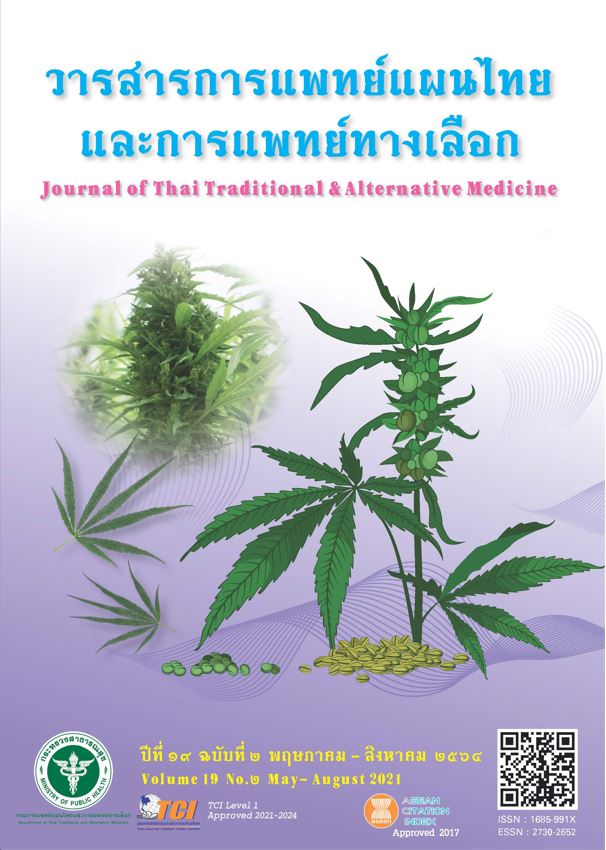Development of Sukkasemnoi Traditional Medicine in Tablet Dosage Form
Main Article Content
Abstract
Sukkasemnoi recipe is a Thai traditional medicine indicated for insomnia. The objective of this study was to
develop Sukkasemnoi recipe in tablet dosage form. The study was divided into three parts: (1) preformulation study: micromeritic studies including microscopic study, sieve analysis and flow property study; (2) tablet preparation using wet granulation method; and (3) tablet evaluation. Results and discussion: (1) Microscopic study revealed irregular particle shapes and wide particle size distribution of crude drug powder. Sieve analysis showed a bimodal distribution with an average particle size of 622.41 microns. Angle of repose was 38.99 ± 0.94 degrees; and its bulk density, tapped density and compressibility index were 0.41 g/ml, 0.67 g/ml and 38.33%, respectively, indicating poor flow property. (2) Tablet preparation: The tablets were prepared by wet granulation. Each 500-mg tablet contained 250-350 mg of the active ingredient. (3) Tablet evaluation: Physical appearance of the prepared tablets was brownish green in color with a mild characteristic odor and bland taste. Selected formulations had acceptable physical properties (weight variation, friability, disintegration time) according to the United States Pharmacopeia, Volume 42. Drug release at 30 minutes (T30) was greater than 80%. Accelerated stability testing revealed that heat and humidity had a significant effect on physical properties of the tablets.
Article Details
References
Khun Sopitbannaraksa (Kittikachorn A.). Textbook of Thai traditional medical book 1. Bangkok: Cabinet and
Royal Gazette Publishing Office; 1970. (in Thai)
Summers M. Powders and granules. In: Aulton ME, editor. Pharmaceutics the Science of Dosage Form Design.
Spain: Churchill Livingstone; 2002. p. 361-3.
Luangtaweepon I, Pleuktivorapongkul A, Sirithunyalug J, Leesawat P, Charumanee S, Yotsawimonwat S. Effects
of herbal powder composition on flow and compaction properties. Proceedings of 49th Kasetsart University Annual Conference: Plants; 2011 Feb 1-4; Bangkok, Thailand. Bangkok: 2011. p. 113-20. (in Thai)
Qusaj Y, Leng A, Alshihabi F, Krasniqi B, Vandamme T. Development strategies for herbal products reducing the influence of natural variance in dry mass on tableting properties and tablet characteristics. Pharmaceutics.
;4(4):501-16.
Sachan AK, Kumar A. Stability testing of herbal products. Journal of Chemical and Pharmaceutical Research.
;7(12):511-4.
Pandey H, Srivastava S, Mishra B, Saxena R, Tripathi YB. Development and evaluation of herbal tablet
loaded with Pueraria tuberosa water extract with use of different excipients. Asian Journal of Pharmaceutics.
;12(Suppl2):S786-93.
Monton C, Saingam W, Suksaeree J, Sakunpak A. Physical properties of herbal tablets (Jit Tra Rom Recipe)
prepared by wet granulation method. Journal of Thai Traditional & Alternative Medicine. 2014;12(2):159-66.
(in Thai)
Sinko P. Chapter 18 Micromeritics. [Internet]. 2017 [cited 2020 Mar 23]; [49 screens]. Available form: http://
copharm.uobaghdad.edu.iq/
Monton C, Kraisintu K, Suksaeree J, Charoenchai L. Flowability study of herbal powder for solid dosage
form preparation. Science and Technology Journal. 2014;22(5):743-54. (in Thai)
The United States Pharmacopeial Convention. The United States Pharmacopeia 35/The National Formulary
Maryland: United Book Press; 2012. The United States Pharmacopeial Convention. The United States
Pharmacopeia 42/The National Formulary 37. Maryland: United Book Press; 2019.
Vutthipong A, Saingam W, Panrat T, Charoonratana T. Dissolution profile of a traditional Thai antihypertensive herbal recipe in various preparations. BHST. 2014;12(2):20-4.
World Health Organization. Guidelines for stability testing of pharmaceutical products containing well
established drug substances in conventional dosage forms. WHO Technical Report Series. 1996;863:65-79.
Kumadoh D, Ofori-Kwakye K. Dosage forms of herbal medicinal products and their stability considerations -
An overview. J Crit Rev. 2017;4(4):1-8.
International conference on harmonization of technical requirements for registration of pharmaceuticals for human use, ICH harmonized tripartite guideline: Stability testing of new drug substances and products
Q1A (R2). [Internet]. 2003 [cited 2020 Dec 29]; Available form: https://database.ich.org/sites/default/files/
Q1A%28R2%29%20Guideline.pdf
Kasperek R, Zimmer L, Zun M, Dwornicka D, Wojciechowska K, Poleszak E. The application of povidone
in the preparation of modified release tablets. Curr. Issues Pharm. Med. Sci. 2016;29(2):71-8.
Tomar M, Kumar SA, Raj SA. Effect of moisture content of excipient (microcrystalline cellulose) on direct compressible solid dosage forms. IJPSR. 2017;8(1):282-8.
Thapa P, Lee AR, Choi DH, Jeong SH. Effects of moisture content and compression pressure of various deforming granules on the physical properties of tablets. Powder Technology. 2017;310:92-102.


